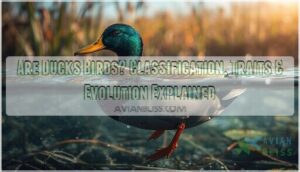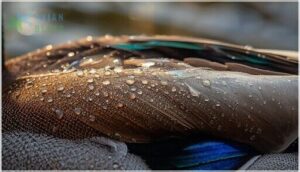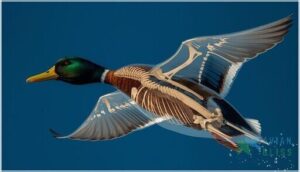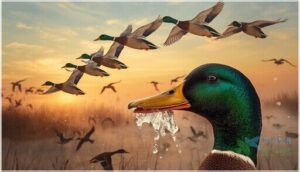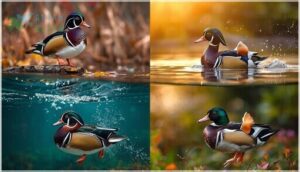This site is supported by our readers. We may earn a commission, at no cost to you, if you purchase through links.
You probably haven’t lost sleep wondering if ducks are birds, but the question pops up more often than you’d think. The short answer? Absolutely, yes.
Ducks belong to the class Aves, sitting comfortably within the family Anatidae alongside swans and geese. They’ve got everything that defines a bird: feathers made of keratin, beaks instead of teeth, hollow bones that keep them light, and they lay eggs.
What makes ducks especially interesting is how they’ve fine-tuned these standard bird features for life on the water. Their waterproof plumage, webbed feet, and filter-feeding bills show how one branch of the bird family tree adapted to thrive in ponds, lakes, and wetlands across the globe.
Table Of Contents
Key Takeaways
- Ducks are classified as birds in the class Aves, sharing all key avian traits like feathers, beaks, hollow bones, and egg-laying.
- Their waterproof feathers, webbed feet, and specialized bills make ducks perfectly adapted for life in water.
- Ducks display classic bird behaviors, including migration, flocking, preening, and a wide range of vocal and visual communication.
- The Anatidae family includes over 160 duck species, showing huge diversity in habitats, physical features, and evolutionary history.
What Are Birds and How Are Ducks Classified?
You’ve probably seen ducks paddling around a pond and wondered if they’re really birds or something a bit different. The answer is yes, ducks are absolutely birds, and understanding why comes down to looking at what makes a bird a bird in the first place.
Let’s break down the key features that define birds, explore how scientists organize them into groups, and see exactly where ducks fit into the picture.
Defining Characteristics of Birds
Birds share five defining avian characteristics that set them apart. You’ll recognize them by their feather composition—keratin-based structures providing insulation and flight capability. They’re warm-blooded, maintaining endothermy with body temperatures around 39–44°C.
Their skeletal adaptations include hollow bones for lightweight flight, while beak morphology replaces teeth entirely.
The Class Aves and Bird Classification
When you’re exploring avian classification, you’ll find that the class Aves encompasses approximately 11,131 recognized living species across 252 distinct families. This taxonomic framework relies on molecular phylogenetics and ongoing consensus-building among ornithological experts.
The Aves definition has evolved through genomic and morphological data integration, ensuring accurate species identification. Within this classification system, the Anatidae family—including ducks—represents one specialized branch of this diverse avian lineage.
Birds also possess lightweight, hollow bones which aid in flight.
Scientific Classification of Ducks as Birds
Now that you’ve seen where ducks fit in the broader avian classification, let’s pinpoint their exact scientific position. Ducks belong to the order Anseriformes and the family Anatidae, which is monophyletic—meaning all 170-plus species share a single common ancestor.
This duck taxonomy confirms their avian ancestry through DNA analysis, placing them firmly within the bird family tree alongside geese and swans, with duck phylogeny showing species diversity across global habitats.
Key Physical Characteristics That Make Ducks Birds
If you’ve ever watched a duck paddle across a pond, you’ve probably noticed it shares a lot with other birds you know. From feathers to beaks, ducks carry the telltale markers of the bird family, though some of their traits are specially tuned for life in the water.
Let’s walk through the key physical features that confirm ducks are, without a doubt, birds.
Feathers and Water-Repellent Plumage
You’ve probably noticed how water beads right off a duck’s back—that’s no accident. Feather microstructure creates this waterproof magic through tiny, interlocking barbules that form a tight shield.
The preen gland adds oil during plumage maintenance, boosting water repellency even more. This remarkable aquatic adaptation keeps ducks dry and warm, showcasing how specialized feathers truly define them as birds.
Beaks, Wings, and Skeletal Structure
Beak morphology in ducks reveals their bird identity. Those wide, flat bills range from 4.4 to 6.1 cm and adapt perfectly for filter-feeding.
Wing strength comes from a strong skeleton with humerus, radius, and ulna bones, supporting both flight and swimming.
You’ll find 14–15 cervical vertebrae providing vertebral flexibility for feeding. This bone composition and skeletal adaptations showcase classic avian anatomy.
Webbed Feet and Aquatic Adaptations
Through millions of years of evolutionary origins, webbed feet transformed ducks into masters of aquatic life. You’ll notice these notable waterfowl propel themselves at 0.3 to 0.6 m/s through hydrodynamic efficiency.
Duck adaptations for swimming include:
- Foot morphology with three forward toes maximizing surface area
- Foraging adaptations enabling rapid movement between feeding sites
- Thermoregulation systems acting as heat exchangers in cold water
- Flexible webbing optimizing paddling power
These water birds showcase perfect aquatic specialization while remaining distinctly avian.
Egg-Laying Reproduction
Like all birds, ducks reproduce through oviparity—laying eggs with hard shells rather than birthing live young. Female ducks begin this egg-laying process around 5 to 7 months of age, generally depositing one egg each morning.
| Feature | Duck Eggs | Chicken Eggs |
|---|---|---|
| Clutch Size | 8-15 eggs | 10-12 eggs |
| Egg Incubation | 28 days average | 21 days |
| Laying Frequency | 250-340 annually | 200-300 annually |
These larger eggs, with higher fat content and varied eggshell colors, demonstrate the oviparity evolution shared across 10,000+ avian species.
Duck Behavior and Bird-Typical Traits
Ducks don’t just look like birds—they act like them too. From migrating thousands of miles each year to communicating with distinct calls, ducks display behaviors you’ll recognize across the entire bird world.
Let’s explore the key behavioral traits that confirm ducks are absolutely, without question, birds.
Migration Patterns and Seasonal Movement
You’ll see ducks vanish from your local pond each fall—that’s migration at work. North America’s four major flyways guide roughly 34 million breeding ducks annually, with timing triggered by temperature drops and shorter days. Peak movements happen mid-November as birds navigate toward warmer climates.
- Energy expenditure during migration can reduce body mass by 7-9% during extended flights
- Climate impacts are shifting migratory timing, with warmer winters delaying departure
- Stopover ecology relies on staging lakes where ducks rest before continuing their journey to breeding grounds
Vocalization and Communication Methods
You might think ducks just quack, but their vocal repertoire involves up to 16 distinct sounds used in different social contexts. Female mallards adjust acoustic structure through decrescendo calls and feeding chuckles, while males use specialized courtship vocalizations—classic bird behavior. Beyond quacking sounds, ducks blend visual signals (postural displays) and chemical cues from uropygial gland secretions to communicate their avian nature.
| Communication Type | Purpose | Example |
|---|---|---|
| Vocal calls | Alarm, courtship, coordination | Decrescendo calls, feeding chuckles |
| Visual displays | Territory defense, mating | Plumage exposure, bill positioning |
| Chemical signals | Mate recognition, sex identification | Uropygial gland secretions with volatile compounds |
| Combined signals | Group cohesion during foraging | Vocalizations + tactile cues in mixed flocks |
Social Structure and Flocking Behavior
Ducks don’t wander alone—they’re textbook social birds that organize into flocks with fascinating structure. You’ll observe dominance hierarchies among males competing for resources, while female common eiders choose nesting spots alongside genetic relatives, forming kin-based groups.
This kinship extends through brood rearing, with cooperative breeding behaviors like crèching, where ducklings join larger broods. Flocking provides anti-predator benefits through collective vigilance, and spatial dynamics shift as groups adapt movement patterns to habitat patches and energetic demands.
Preening and Feather Maintenance
Beyond social bonds, you’ll notice ducks constantly grooming their plumage—preening is essential bird behavior. Their uropygial preen gland secretes specialized wax-rich oils that coat contour feathers, maintaining waterproof feathers and repelling water.
Environmental preening influences matter: ducks with water access show 24.8% wet preening frequency versus just 5.5% without. This feather health impacts buoyancy, insulation, and overall welfare through sustained feather water repellency.
Duck Diversity Within The Anatidae Family
The Anatidae family is like a big, bustling neighborhood where ducks come in all shapes, sizes, and styles. From puddle ducks bobbing in ponds to diving ducks plunging deep underwater, you’ll find remarkable variety across more than 160 species worldwide.
Let’s look at how these birds differ in their habitats, physical traits, and the environments they call home.
Major Duck Species and Their Habitats
Across continents, duck species and duck habitats reveal striking diversity shaped by ecological requirements and regional trends. You’ll find mallards thriving in North American prairies, wood ducks nesting in eastern swamps, and king eiders breeding on Arctic tundra.
Consider these wild duck species by habitat:
- Freshwater ducks like mallards inhabit ponds and marshes
- Marine species such as long-tailed ducks prefer coastal waters
- Tropical ducks occupy Asian rice paddies
Habitat loss threatens conservation status, with wetlands declining 30% over six decades, affecting species distribution patterns you observe today.
Physical Variations Across Duck Types
When you compare duck characteristics across species, you’ll notice striking differences in duck plumage—mallards show over 50% green head coverage, while Mexican ducks have none. Bill morphology varies too, with mallard bills averaging 4.6–5.7 cm versus teal bills at 3.2–3.8 cm.
Size dimorphism is clear: male mottled ducks weigh 876–1241 g, females just 699–1151 g. Skeletal adaptations and webbed feet reflect each species’ lifestyle.
Freshwater Vs. Marine Duck Species
You’ll find ducks split between freshwater and marine environments, with about 120 species adapted to coastal or oceanic regions. Here are key differences:
- Habitat Differences: Freshwaters like lakes host mallards, while sea ducks prefer estuaries
- Feeding Habits: Dabbling ducks eat plants; marine species dive for mollusks
- Salinity Tolerance: Scoters and eiders thrive in saltwater
- Migration Routes: Coastal waterfowl follow shorelines
- Conservation Needs: Each aquatic birds group faces unique threats
Evolutionary Relationship Between Ducks and Other Birds
Ducks didn’t just appear out of nowhere—they share a long evolutionary history with other birds that stretches back millions of years.
Understanding where ducks fit in the grand family tree of birds helps you see how they’re connected to everything from songbirds to seabirds.
Let’s look at the key connections that show how ducks evolved alongside their feathered relatives.
Shared Ancestry Within Avian Evolution
When you trace duck evolutionary history back, you’ll find stunning evidence that ducks’ ancestors shared the planet with theropod dinosaurs over 65 million years ago. Vegavis iaai, a fossil duck ancestry link, survived the mass extinction event that ended the Cretaceous period.
Ducks’ ancestors shared the planet with theropod dinosaurs over 65 million years ago, surviving the mass extinction that ended the Cretaceous period
| Evolutionary Event | Timeframe |
|---|---|
| Duck relatives alongside dinosaurs | 65+ million years ago |
| Anseriformes divergence from other avian lineages | 90–100 million years ago |
| Crown-clade Anatidae origin | ~19 million years ago |
| Modern duck diversification | ~5.3 million years ago |
Genomic findings show around 5.2% of duck genes are under positive selection, revealing how ancestral traits evolved. Modern divergence timelines indicate domestic ducks separated from mallards approximately 38,000 years ago, demonstrating recent bird evolution within this ancient lineage.
Waterfowl Position in Bird Taxonomy
Within avian taxonomy, waterfowl occupy a fascinating niche. You’ll find ducks classified under the order Anseriformes, which branches into four families—with Anatidae housing the most diversity.
This family splits into subfamilies like Anatinae (ducks) and Anserinae (geese and swans), showing geese divergence from ducks millions of years ago. Duck speciation accelerated during the Plio-Pleistocene, creating today’s global distribution across freshwater and marine habitats.
How Ducks Fit Into The Broader Bird Family Tree
Across the vast avian phylogeny, you’ll see ducks branch from a common ancestor shared with all birds around 90–100 million years ago. Duck divergence from chickens and turkeys marks a distinct evolutionary history.
Today, phylogenetic analysis using genetic diversity data places ducks firmly within waterfowl taxonomy—a specialized lineage shaped by aquatic life, yet unmistakably tied to the broader avian classification system.
Frequently Asked Questions (FAQs)
Are ducks mammals?
No, ducks aren’t mammals. They’re birds with feathers, beaks, and egg-laying reproduction. Unlike mammals with fur and live births, ducks display defining avian traits that clearly separate them from mammalian species evolutionarily.
Are ducks waterfowl?
Yes, you could say ducks are indeed waterfowl—members of the Anatidae family, which includes geese and swans.
Their aquatic adaptations, like webbed feet and water-repellent feathers, perfectly suit these water birds for life in aquatic environments.
Is a duck a bird?
Absolutely. Ducks belong to the class Aves, sharing defining bird traits like feathers, beaks, and egg-laying. Their position within Anatidae confirms their avian classification, making them true waterfowl species with unique aquatic adaptations.
Are ducks avian?
Though often seen as purely aquatic, ducks are avian through and through. You’ll find them classified within class Aves, displaying every bird trait—feathers, beaks, hollow bones, and egg-laying reproduction.
Are ducks water birds?
Without question, they’re classic water birds. Their webbed feet, waterproof plumage, and wetland dependency mark them as waterfowl perfectly adapted to aquatic habitats—from marshes to coastal waters where they thrive through specialized swimming and foraging.
What do ducks eat in the wild?
Ducks have a diverse diet, which includes aquatic plants, invertebrates, and seasonal foods like seeds. Their foraging techniques include dabbling and diving.
Ducklings require a protein-rich diet of invertebrates, while adults shift toward vegetation, depending on duckling nutrition requirements and food availability.
How long do ducks typically live?
Wild duck lifespan ranges from 5 to 12 years, while domestic duck breeds often reach 10 to 15 years with proper care.
Factors affecting longevity include predation, disease, habitat quality, and genetics across duck species.
Can all duck species actually fly?
Most duck species can fly, but not all. Flightless duck breeds like Pekins and some steamer duck evolution lineages lost this ability through genetic flight loss or increased wing loading effects, especially in island duck flight populations.
Are ducks endangered or threatened globally?
Most duck species aren’t globally threatened—about 80 species exist, with the majority listed as Least Concern. However, twelve species face serious danger from habitat loss, pollution, predators, and hunting pressure worldwide.
How do ducks impact agriculture and farming?
Like farmers who’ve welcomed unexpected helpers, you’ll find domestic ducks (Anas platyrhynchos domesticus) offering pest biological control, enriching soil fertility, and generating economic outcomes—though duck farming presents management challenges alongside its biodiversity effects.
Conclusion
Like puzzle pieces snapping into place, everything about ducks—from their hollow bones to their rhythmic quacks—confirms they’re birds through and through. They’ve simply mastered a niche that many of their feathered relatives never explored.
So next time you watch a mallard glide across a pond, you’re witnessing millions of years of avian evolution perfectly adapted to life between sky and water.

